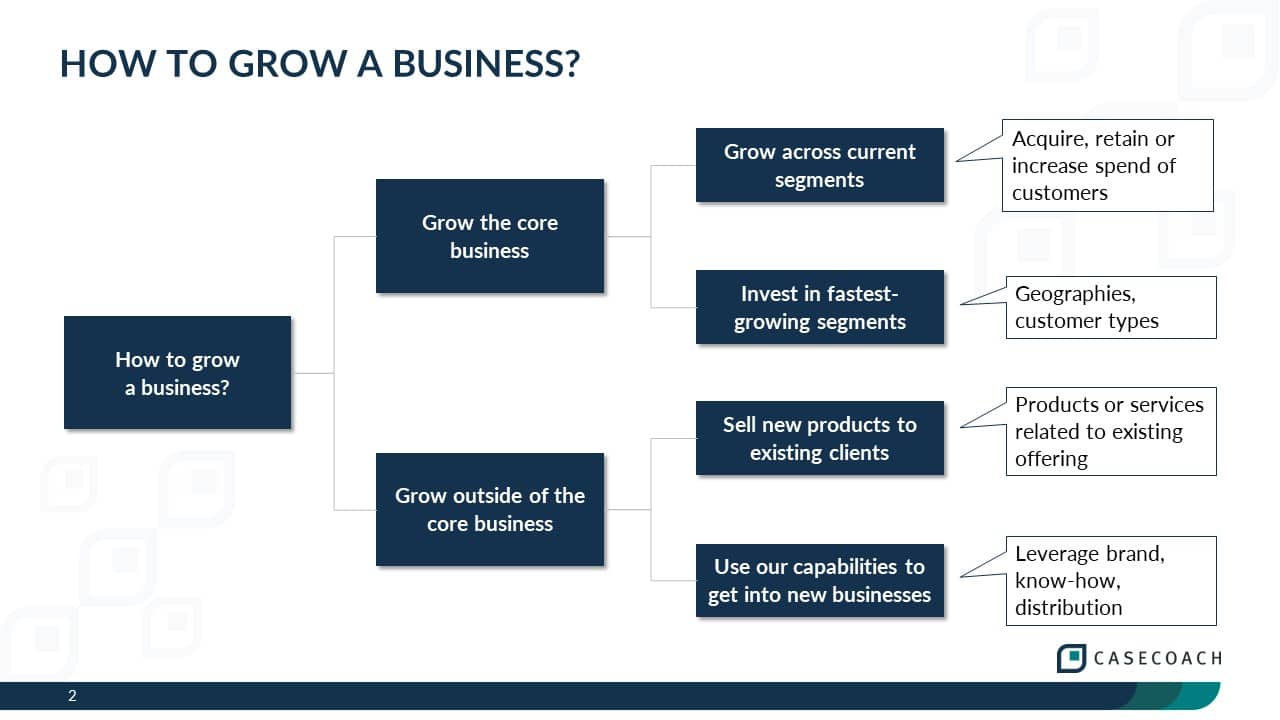You’ve just been given a case question on growing an existing business. It’s up to you to organize your ideas into a structure that’s going to set you up for success.
The chances of being faced with this scenario in a case interview are high. In our 2023 analysis of case study interview questions at McKinsey, BCG and Bain, revenue growth was the second-most frequently cited topic, accounting for 15% of the case questions reported.
Here’s a framework we’ve developed to help you tackle case questions on revenue growth with clarity and confidence.
The two main ways to grow a business
The revenue growth framework is based on the principle that there are two main ways to grow a company’s revenue:
- Growing its core business
- Growing outside of its core business
To grow the core business, you could:
- grow across your current market segments
- and/or invest in the fastest-growing segments in the market
To grow across your current market segments you might look at how you could acquire or retain customers and increase how much they spend.
To invest in the fastest-growing market segments, you could look at the geographies, types of customers or product lines that are likely to experience the fastest growth.
To grow the business outside of its core offering, you could:
- sell new products to your current clients
- and/or leverage your capabilities to get into new business areas
To sell a new product to your current clients, you might look at introducing products that are similar or related to your existing products. These are options that will seem like a natural extension of your current offering. Your client might purchase these new products or services either when they buy your existing products or at a later stage.
To use your capabilities to get into new businesses, you would look at the assets that give your company a competitive advantage. These might include its brand, know-how, distribution network, or production facilities. You would then look at products and services that could make the best use of these assets.
To use this revenue growth framework in a case interview, draw two branches or ‘buckets’ to represent the main ways to grow a business. Then unpack the next level of detail in each subsequent branch, as shown in the example below.

The revenue growth case framework in practice
When you put this framework to use in a case interview, it’s vital that your segmentation and ideas are relevant to the client and their industry. You shouldn’t simply regurgitate the same structure for each case.
Imagine you’re a car maker with a strong presence in the SUV market. If you were to grow within that market, you might consider making better cars, improving your marketing, or offering competitive prices.
If you were to think about positioning your brand to maximize long-term growth you might invest in electric vehicles, a new low-cost line of cars, or possibly in the Asian market.
If you were to grow outside of your core business, you could sell new products – such as insurance and maintenance plans – or consider leasing to your current clients.
Alternatively, you could use your capabilities to get into new business areas, such as trucks, buses or motorbikes.
Remember that when you answer a case question on revenue growth, it’s important to identify the most relevant drivers for the situation you’ve been asked to consider. For instance, it wouldn’t make much sense for a startup that’s trying to establish itself in its core market to even consider growing outside of it. What would make sense will depend on a number of factors, such as time horizon, market maturity, and the position of the company in its market.
In any case, the revenue growth framework is an excellent starting point and a strong foundation from which to drive the rest of the case. You can learn more about how to use the framework – along with nine others that will help you answer the most common case interview questions – in the Case Interview Prep Course, included in our Consulting Interview Prep Toolkit.
Designed to teach you how to tackle each dimension of the case and fit interviews, the Toolkit contains all the online courses, sample interviews, case material, and practice tools you’ll need to ace any case interview. This includes access to our Case Library of over 100 cases, which span a range of sectors, functions and question types, including revenue growth.







